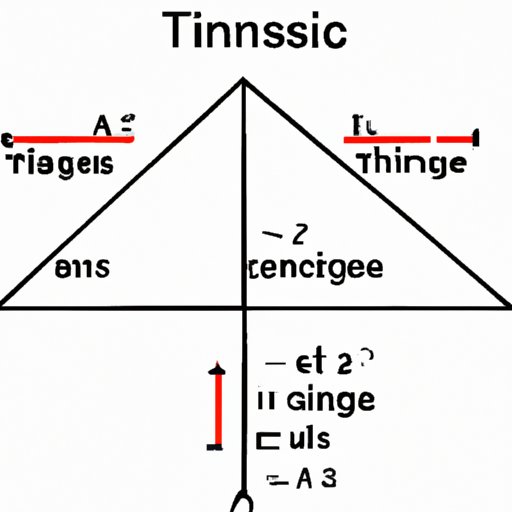
I. Introduction
Triangles are one of the most fundamental shapes in mathematics, and they are present in countless real-world applications. Being able to find the length of a triangle’s sides is an essential skill in many fields, including architecture, engineering, and physics. In this article, we will cover five easy steps to finding the side of a triangle, as well as more advanced techniques like trigonometry, geometry, and the Pythagorean theorem.
II. 5 Easy Steps to Finding the Side of a Triangle
If you know some of the sides and angles of a triangle, you can use basic trigonometry formulas to find the length of the remaining side. The five easy steps are:
- Identify the known information about the triangle
- Apply the appropriate formula or equation
- Simplify the equation and solve for the unknown side
- Check your work by plugging in the values and see if the equation balances out correctly
- Express the answer with appropriate units of measure
Let’s go through an example. Say we have a right triangle with legs of 3 and 4, with an unknown hypotenuse:

- Known information: Legs a = 3, b = 4
- Formula: Pythagorean theorem – c² = a² + b²
- Simplify and solve: c² = 3² + 4² = 25, c = √25 = 5
- Check: c² = 9 + 16 = 25, correct!
- Answer: The hypotenuse is 5 units long.
III. Trigonometry 101: How to find Unknown Sides of a Triangle
Trigonometry is the study of relationships between angles and sides of triangles. It provides several formulas that can be used to find unknown sides or angles. The three primary trigonometric functions are sine, cosine, and tangent:
- Sine (sin): opposite/hypotenuse
- Cosine (cos): adjacent/hypotenuse
- Tangent (tan): opposite/adjacent
Let’s say we have a triangle with an angle of 30° and a hypotenuse of 4 units:

We can use the sine and cosine functions to find the lengths of the two sides:
- Known information: ∠A=30°, hypotenuse c = 4
- Formulas: sin(∠A) = a/c, a = c × sin(∠A) = 4 × sin(30°) = 2, cos(∠A) = b/c, b = c × cos(∠A) = 4 × cos(30°) = 3.46 (rounded to two decimal places)
- Answer: Side a is 2 units long and side b is 3.46 units long.
IV. Solving for Sides: A Guide to Finding the lengths of Triangles
In addition to trigonometry, there are several other methods for finding the sides of a triangle. The law of sines and the law of cosines can be used to solve triangles that don’t have a right angle. Special triangles, such as 30-60-90 or 45-45-90 triangles, have well-known ratios that can be used to find their side lengths. Similar triangles can also be used to find side lengths, by comparing corresponding sides and using the ratios of their lengths.
Let’s say we have a triangle with sides of length 6, 7, and 8:

We can use the law of cosines to find the unknown side c:
- Known information: a = 6, b = 7, ∠C = 60°
- Formula: c² = a² + b² – 2ab cos(∠C)
- Simplify and solve: c² = 6² + 7² – 2(6)(7)cos(60°) = 120.5, c = √120.5 = 10.97 (rounded to two decimal places)
- Answer: Side c is 10.97 units long.
V. Geometry Made Simple: Discovering the Missing Sides of a Triangle
Basic geometry concepts like the Pythagorean theorem can also be used to find missing sides of a triangle. The Pythagorean theorem states that the sum of the squares of the two legs of a right triangle equals the square of the hypotenuse.
Let’s say we have a right triangle with legs of 3 and 4, with an unknown hypotenuse:

We can use the Pythagorean theorem to find the length of the hypotenuse:
- Known information: Legs a = 3, b = 4
- Formula: Pythagorean theorem – c² = a² + b²
- Simplify and solve: c² = 3² + 4² = 25, c = √25 = 5
- Answer: The hypotenuse is 5 units long.
VI. Mastering Pythagoras: Tips and Tricks for Finding Side Lengths of Right Triangles
Here are some additional tips and tricks for finding side lengths in right triangles:
- Recognize when a triangle is a right triangle
- Use Pythagorean triplets, such as 3-4-5 or 5-12-13
- Use the 3-4-5 rule, which states that if the legs of a right triangle have lengths of 3 and 4, then the hypotenuse must have a length of 5 (and this can be scaled up or down)
Let’s say we have a right triangle with a leg of length 8:

We can use the 3-4-5 rule to quickly find the length of the other leg and the hypotenuse:
- Known information: Leg a = 8
- Formula: 3-4-5 rule – leg b = 6, hypotenuse c = 10
- Answer: The other leg is 6 units long and the hypotenuse is 10 units long.
VII. Conclusion
Finding the side of a triangle is a fundamental math skill that has numerous real-world applications. Whether using basic trigonometry formulas, more advanced methods like the law of sines, or basic geometry concepts like the Pythagorean theorem, there are many ways to calculate the length of a missing side. By mastering these techniques and practicing with multiple examples, you too can become an expert in finding the side of a triangle.





